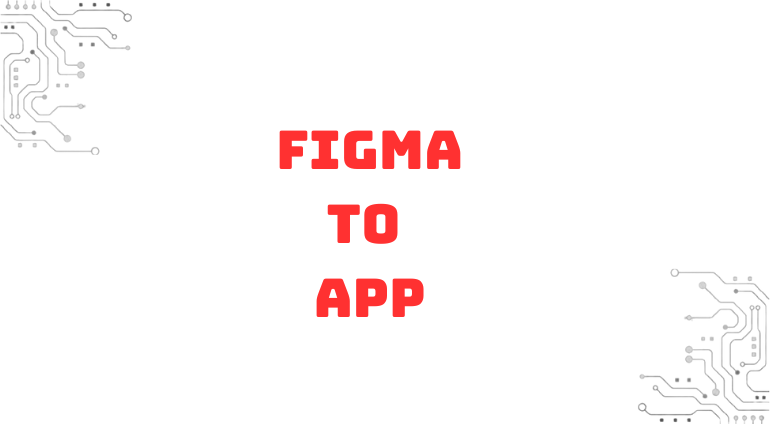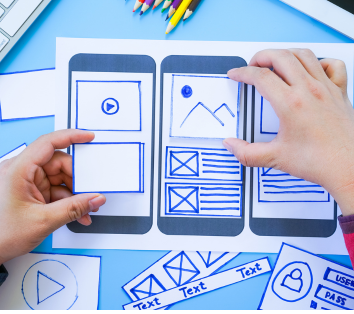
Building a Figma prototype before starting the development of a mobile app offers numerous advantages. Figma is a powerful design tool that allows teams to create interactive and highly detailed prototypes, which can significantly enhance the development process. Here are the key benefits of using Figma for prototyping:
1. Clear Visualization of Ideas:
> Interactive Mockups: Figma enables the creation of interactive mockups that simulate the user experience of the final app.
This helps stakeholders visualize how the app will function and look, providing a clear understanding of the project from
the outset.
> Design Consistency: With Figma, designers can ensure consistency across the app’s UI elements, maintaining a
cohesive look and feel throughout the prototype.
2. Enhanced Collaboration:
> Real-Time Collaboration: Figma supports real-time collaboration, allowing designers, developers, and stakeholders
to work together on the same project simultaneously. This feature facilitates immediate feedback and ensures that everyone is
on the same page.
> Centralized Feedback: Figma allows team members to leave comments directly on the prototype. This centralized feedback
mechanism streamlines the review process and helps in addressing issues quickly.
3. Improved Communication:
> Shared Understanding: A detailed Figma prototype serves as a visual reference for the development team, reducing
misunderstandings and ensuring that the developers have a clear understanding of the design requirements.
> Client and Stakeholder Approval: Prototypes can be shared with clients and stakeholders for approval before development
begins, ensuring that the project meets their expectations and requirements.
4. Efficient Development Process:
> Reduced Rework: By finalizing the design and user experience during the prototyping phase, teams can minimize changes
during development, leading to a more efficient and cost-effective process.
> Detailed Specifications: Figma prototypes can include detailed specifications for UI elements, interactions, and animations,
providing developers with precise guidelines to follow during implementation.
5. User Testing and Validation:
> Early Testing: Prototypes allow for early user testing, enabling teams to gather valuable feedback from potential users and
make necessary adjustments before development. This helps in validating the design and functionality, ensuring a user-centric approach.
> Iterative Improvements: Based on user feedback, the prototype can be iteratively refined to enhance usability and user
satisfaction before the coding phase begins.
6. Cost and Time Savings:
> Identifying Issues Early: Prototyping helps in identifying design flaws and usability issues early in the process,
reducing the risk of costly changes during development.
> Streamlined Workflow: With a well-defined prototype, the development team can follow a clear roadmap, reducing the time
spent on design-related clarifications and iterations.
7. Enhanced Creativity and Innovation:
> Exploration of Ideas: Figma’s flexible design environment allows designers to experiment with different ideas and
interactions, fostering creativity and innovation.
> Rapid Iteration: The ability to quickly iterate on designs in Figma enables teams to explore various solutions and
select the best one, leading to a superior final product.
Building a Figma prototype before developing a mobile app provides a solid foundation for the project. It enhances visualization, collaboration, communication, and efficiency, while also enabling early user testing and validation. By investing time in creating a detailed prototype, teams can streamline the development process, reduce costs, and ultimately deliver a high-quality mobile app that meets user needs and expectations.

This is what you gain with your own Figma prototype:
A: This is what you can expect from a Figma prototype:
1. Interactive Components: Figma allows you to create interactive elements within your prototype, such as buttons,
links, and menus, which users can click or interact with to simulate the actual app experience.
2. Transitions and Animations: You can add transitions and animations to your prototype to simulate user interactions
and provide a more dynamic and engaging experience.
3. Hotspots: Hotspots are areas within your prototype that users can interact with to trigger actions or navigate to
different screens. They help simulate the flow of the app and create a more intuitive user experience.
4. Comments and Feedback: Figma allows stakeholders to leave comments directly on the prototype, providing a centralized
feedback mechanism for collaboration and iteration.
5. Device Preview: Figma offers device preview options, allowing you to view your prototype on different devices and
screen sizes to ensure compatibility and responsiveness.
6. Conditional Interactions: With Figma's advanced prototyping capabilities, you can create conditional interactions
based on user inputs or specific conditions, allowing for more complex and realistic simulations.
7. Presentation Mode: Figma provides a presentation mode that allows you to showcase your prototype in full-screen mode,
making it easier to present to clients, stakeholders, or team members.
8. Version History: Figma keeps track of version history, allowing you to review and revert to previous versions of your
prototype if needed, ensuring version control and collaboration efficiency.
9. Collaboration and Sharing: Figma enables real-time collaboration, allowing multiple team members to work on the
prototype simultaneously and share updates instantly. You can also share the prototype with stakeholders for review and feedback.
10. Export Options: Figma offers various export options, allowing you to export your prototype as images, PDFs, or
interactive presentations for sharing or documentation purposes.
A: Building a Figma prototype before development aligns perfectly with the principles of lean process philosophy for several reasons:
1. Early Validation of Ideas: Prototyping allows teams to visualize and test ideas early, validating assumptions
and ensuring the proposed solution solves a real problem or meets user needs.
2. Iterative Development: Prototyping enables teams to iterate quickly on design and functionality, reducing the risk
of building the wrong product and allowing for course correction early in the process.
3. Reduced Rework and Waste: By identifying and addressing design flaws or usability issues early, prototyping minimizes
the need for rework later in development, reducing waste of time, effort, and resources.
4. Improved Collaboration and Communication: Figma's collaboration features facilitate communication and alignment
among team members, stakeholders, and clients, ensuring a shared understanding of project goals and requirements.
5. Focus on Value Delivery: Prototyping helps teams focus on delivering the core features and functionalities that provide
the most value to the user, enabling the launch of a minimum viable product sooner and gathering feedback for iterative improvement.
Overall, incorporating Figma prototyping into the lean process methodology enables teams to build better products more efficiently by validating ideas early, iterating based on feedback, minimizing waste, improving collaboration, and delivering value to the end-user.
A: Building a Figma prototype before development can provide several economic benefits:
1. Cost Savings: Prototyping helps identify design flaws and usability issues early, minimizing the need for
costly changes during development and ultimately reducing project expenses.
2. Time Efficiency: Iterating on design concepts and functionalities in a Figma prototype streamlines the development
process, accelerating time-to-market and enabling quicker delivery of the final product, potentially resulting in faster
revenue generation.
3. Resource Optimization: By focusing efforts on building features and functionalities that add significant value to the
end-user, prototyping optimizes resource allocation, minimizing waste and maximizing the efficiency of development efforts.
4. Risk Mitigation: Early validation of ideas and user testing in a Figma prototype mitigates the risk of building the
wrong product, reducing the likelihood of project delays or cost overruns associated with significant rework.
5. Improved Stakeholder Confidence: Presenting a detailed Figma prototype to stakeholders provides a tangible representation
of the proposed solution, instilling confidence in the project's direction and potentially attracting additional funding or
support for further development.
Overall, leveraging Figma prototyping before initiating software development can result in tangible economic benefits, including cost savings, time efficiency, resource optimization, risk mitigation, and enhanced stakeholder confidence, ultimately contributing to the project's success and profitability.